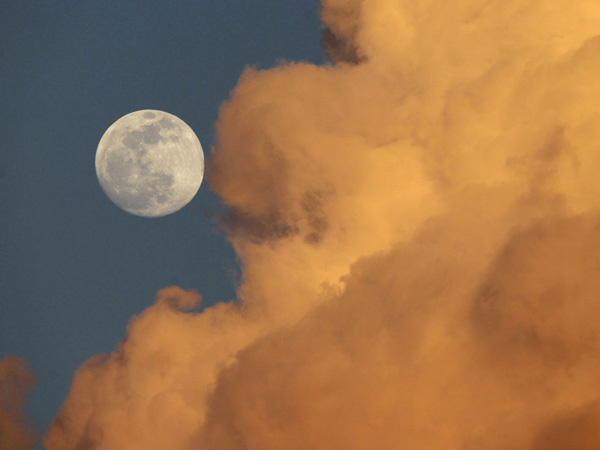Moon may harbor alien minerals—study

Minerals found in craters on the Moon may be remnants of asteroids that slammed into it and not, as long believed, the satellite’s innards exposed by such impacts, a study said Sunday, May 26, 2013. AP PHOTO/THE GAINESVILLE SUN, MATT STAMEY
PARIS—Minerals found in craters on the Moon may be remnants of asteroids that slammed into it and not, as long believed, the satellite’s innards exposed by such impacts, a study said Sunday.
The findings, published in the journal Nature Geoscience, cast doubt on the little we knew of what the Moon is actually composed of.
It had long been thought that meteoroids vaporise on impact with large celestial bodies.
Unusual minerals like spinel and olivine found in many lunar craters, but rarely on the Moon’s surface, were therefore attributed to the excavation of sub-surface lunar layers by asteroid hits.
Olivine and spinel are common components of asteroids and meteorites, and have been found on the floors and around the central peaks of lunar craters like Copernicus, Theophilus and Tycho that are around 100 kilometers (63 miles) in diameter.
A team from China and the United States simulated the formation of Moon craters and found that at impact velocities under 12 kilometers per second a projectile may survive the impact, though fragmented and deformed.
“We conclude that some unusual minerals observed in the central peaks of many lunar impact craters could be exogenic (external) in origin and may not be indigenous to the Moon,” they wrote.
Co-author Jay Melosh from Purdue University in Indiana, said the finding answers the conundrum exposed by earlier studies which said craters the size of Copernicus were not big enough to have dredged up the contents of the Moon’s deep, interior mantle.
“It also warns planetary scientists not to use the composition of the central peaks of craters as a guide to the interior of the Moon, whose dominant mineral might not be olivine,” he told AFP.
On Earth, spinel and olivine create rare gemstones like peridot.
In an article commenting on the study, Erik Asphaug of the School of Earth and Space Exploration at Arizona State University, said the theory meant that material excavated from Earth by large impacts during the planet’s early days may still be found on the Moon.
The scattered material was known to have hit the Moon at velocities as slow as 2 km/s and should have survived, if the study’s assumptions are correct.
This suggested yet another explanation for the existence of spinels on the Moon, said Asphaug: They came from Earth.
“Even more provocative is the suggestion that we might someday find Earth’s protobiological materials, no longer available on our geologically active and repeatedly recycled planet, in dry storage up in the lunar ‘attic.’
“Certainly, the potential of finding early Earth material is emerging as one of the primary motivations for a return to the Moon by human astronauts in our ongoing search for the origin of life.”
Unlike the Earth’s crust, which is repeatedly recycled through the process of plate tectonics, the Moon’s hard crust dates back billions of years, offering clues to the formation of the solar system, including Earth.